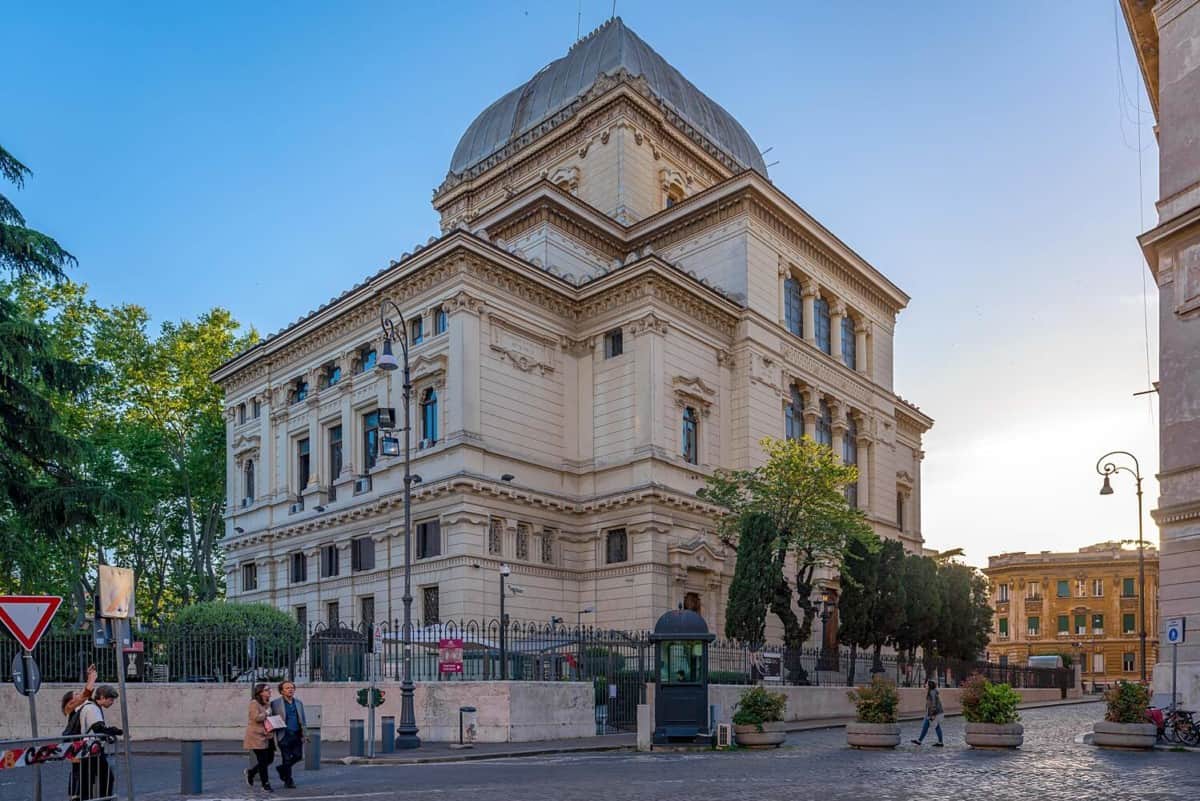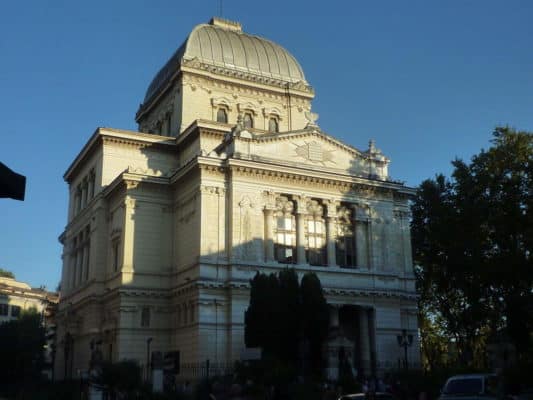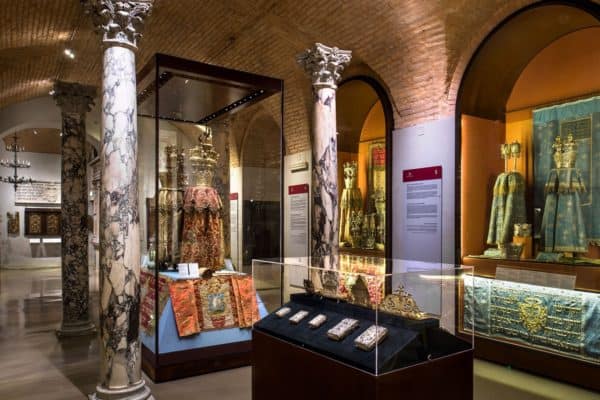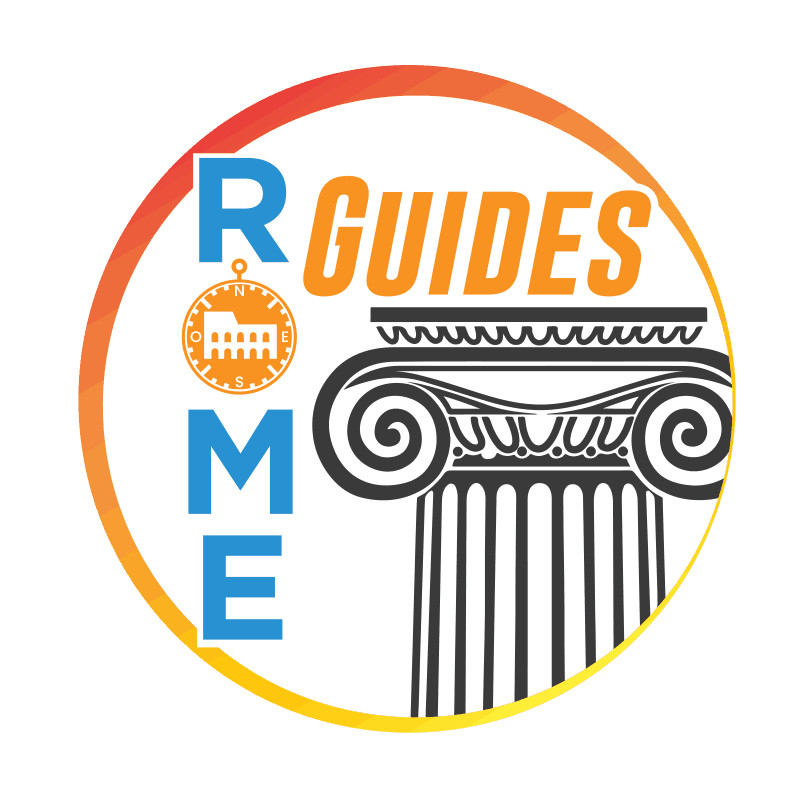ROMAN ITINERARIES – SANT’ANGELO DISTRICT – ITINERARY 42
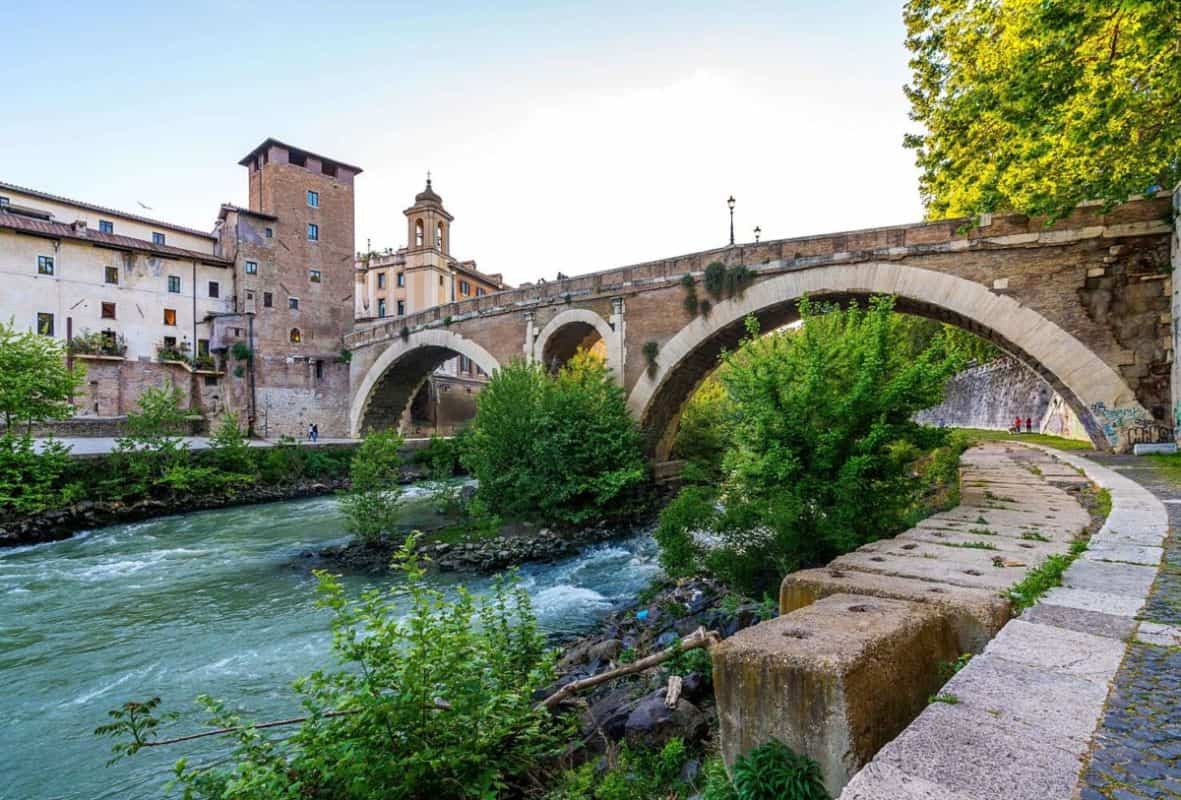
SANT’ANGELO DISTRICT – ITINERARY 42
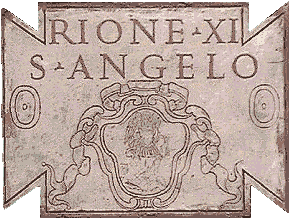
The coat of arms of the District consists of an angel on a red field, with a sword in his right hand and scales in the other one: the angel, more than to justice, referred to the more prosaic work of cutting and weighing fish, which was characteristic of a good part of this area.
At the time of Emperor Augustus, the territory of our District was mainly included in the Regio of Circus Flaminius, inside which the Jewish Ghetto, instituted in 1555, would have been completely included; for this reason, very often the ancient documents refer to this area as “in circus“. In addition to the Circus Flaminius, this area formerly housed the Temple of Apollo Sosianus, another adjacent temple probably dedicated to Bellona, the Temple of Pietas, the Temple of the Dioscuri and the Temple of Diana. The region was very famous for its theaters, the most famous of which was obviously the Theatre of Marcellus, and for its two grand Porticoes, that of Octavia and that of Philip.
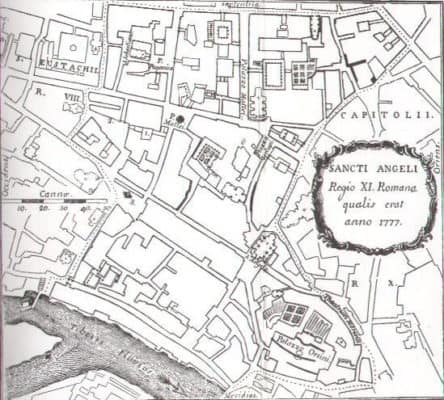
The ultimate delimitation of the District, except for the changes that occurred in the fascist era with the arrangement of Via del Teatro di Marcello and the consequent isolation of the theater itself, took place around 1743 at the time of Pope Benedict XIV. The names of the streets still remind us of the presence of many different working activities, such as lime manufacturers, blacksmiths and pot makers at the Theatre of Marcellus, rope makers in Via dei Funari, wool carders at St. Valentine, and then tailors, perfumers, tanners and especially fish merchants.
The institution of the Jewish Ghetto accentuated the presence of the activities of junk dealers, ragpickers and pawnbrokers, the only ones granted to Jews. Four are the “historical” churches of the District that have arrived to us: St. Angel in the Fish Market, St. Catherine of the Funari, St. Ambrose and St. Stanislaus of the Poles, to which should be added (due to changes in the boundaries between the districts) St. Mary in Campitelli, St. Nicholas in Jail, St. Gregory of the Divine Mercy and St. Rita. Many other historical churches have disappeared, leaving the scholars puzzled about the accuracy of their original location.
The most important alteration of the District was the demolition of the Papal Ghetto. The construction of the embankments along the Tiber altered the medieval appearance, with the construction of the monumental Synagogue at the beginning of the XX Century. As mentioned, in 1932 there was the isolation of the Theatre of Marcellus and of the Capitol, while in 1938 there was the gutting of Via delle Botteghe Oscure: two actions that changed forever the original appearance of the District.
Bridge of the Four Heads – Monte Savello – Via del Foro Olitorio – Via del Teatro di Marcello – Via del Foro Piscatorio – Via del Portico di Ottavia – Piazza delle Cinque Scole – Jewish Synagogue
THE FABRICIUS BRIDGE
The Fabricius Bridge, better known as the Bridge of the Four Heads because of the four-sided herms that adorn it, was also nicknamed the Bridge of the Jews (Pons Judeorum), being in the area mainly inhabited by people from Judea, which helps you to understand how deeply rooted the Jewish presence was in this area of Rome, long before the institution of the infamous Ghetto.
The bridge was built in 62 BC by Lucius Fabricius, in travertine with internal structures in tuff, and restored forty-one years later by the consuls Lepidus and Lollius. It is 62 meters long and has a small archway that lightens the central pylon and that has the task of reducing the impact of flooding of the Tiber, exactly as happens in the Renaissance Sixtus Bridge.
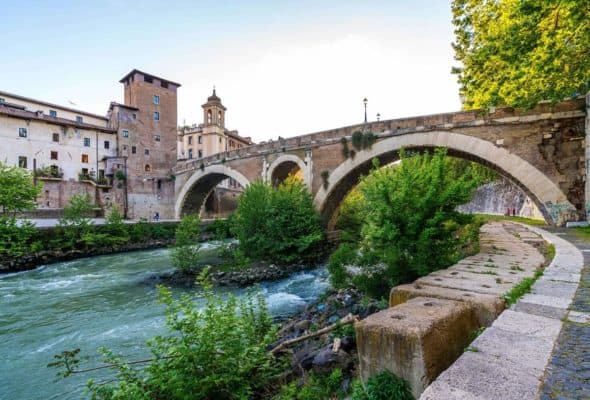
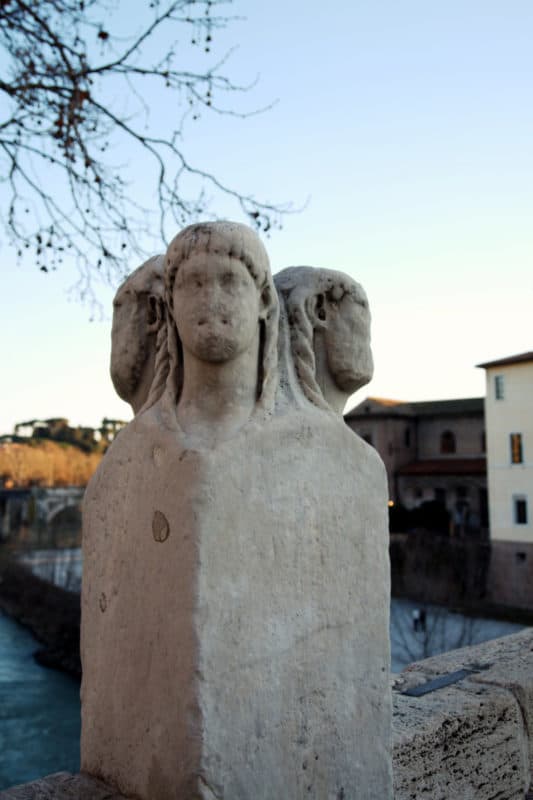
ST. GREGORY OF THE DIVINE PIETY
Turn your back on the river, looking at the small Church of St. Gregory of the Divine Piety in the Monte Savello Square. According to some documents, the Gregory to whom the church is dedicated would be Pope Gregory the Great, one of the most important Pontiffs of the Middle Ages, who, according to some sources, was born in this exact location.
The church became a parish in the 12th Century and remained so despite the fact that it was completely inside the Jewish Ghetto since the 16th Century. This explains the bilingual text (Latin and Hebrew) placed on the façade, under the oval stucco frame with the Crucifix: “All day long I have stretched out my hands to an unbelieving people, who walk according to their own ideas along a path that is not good, to a people who continually, just in front of me, provoke me to anger“.
The present church is the one restored in 1729 by the architect Filippo Barigioni: the interior, renovated in 1858, presents on the altar a 17th Century painting by Gilles Hallet depicting “the Virgin of the Divine Piety” and, a very curious detail, a single painting dedicated to St. Gregory, painted by Etienne Parrocel.
FORCED SERMONS AND ALMS-BOXES
In this church, until the mid-19th Century, the well-known “forced sermons” were held: they were Christian sermons that Jews were forced to listen to and to which they often attended with their ears plugged with wax, so that they would not hear the preacher’s voice. The compulsion of the forced sermons, as we shall see, took place in various places in the Ghetto.
This church, however, was very famous for another activity too. Pope Benedict XIII had indeed assigned it to the Congregation of the Workers of Divine Piety, whose intent was to help noble families on the edge of poverty who were too ashamed to show their condition of indigence. If you take a look at the side of the church facing the river, you can see an alms pit with the inscription (half-deleted) “Elemosina per povere onorate famiglie e vergognose” (“Alms for poor and shameful families”).
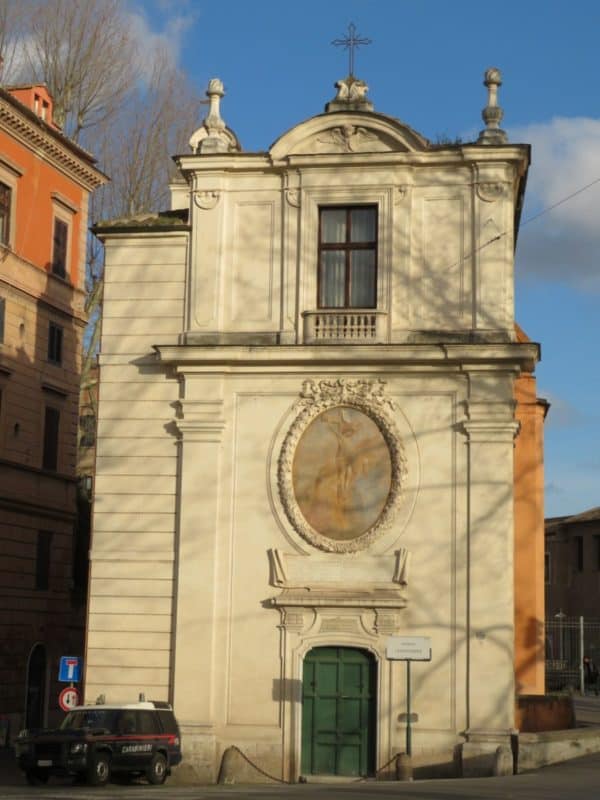
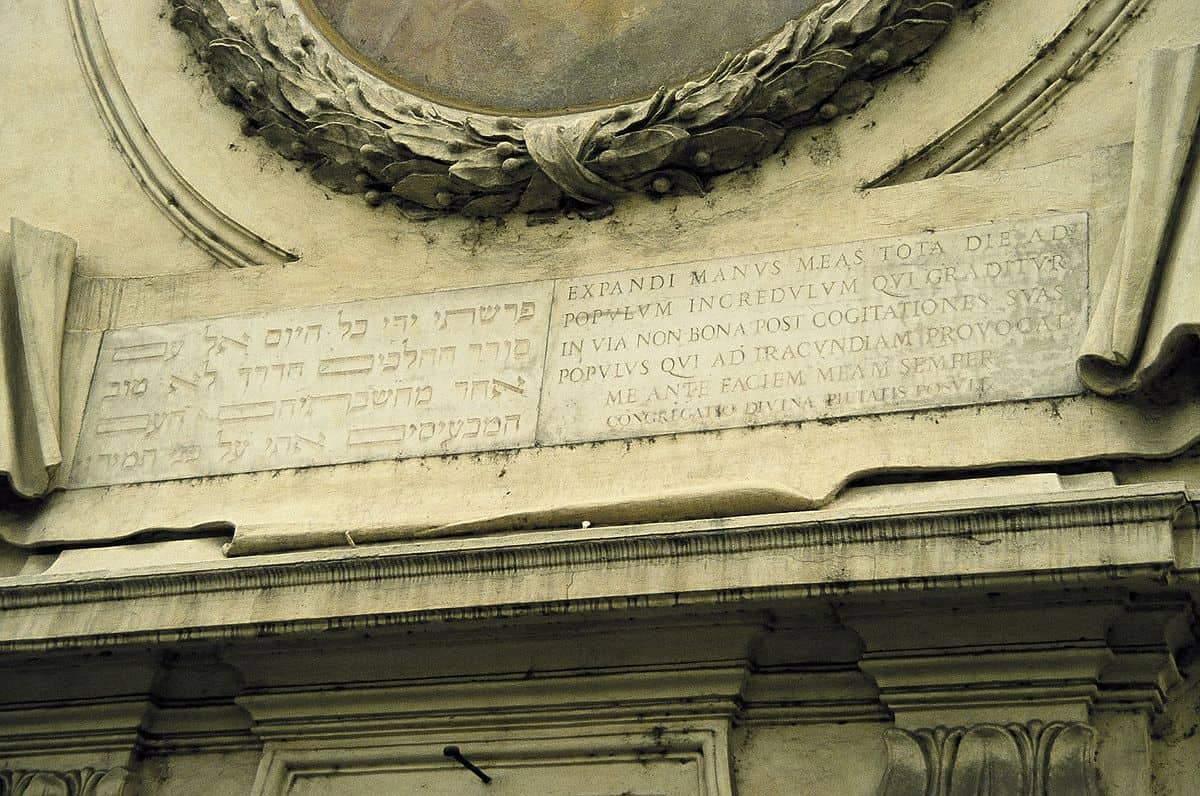
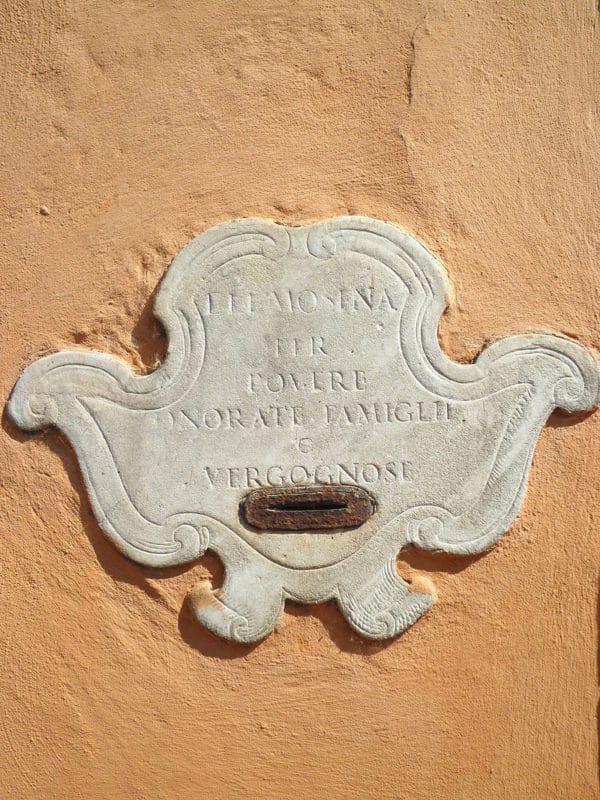
THE ORSINI SAVELLI PALACE
The monumental Orsini-Savelli architectural structure was built in the Middle Ages among the imposing ruins of the ancient Theatre of Marcellus. Before the 11th century, it belonged to the Fabi family, who claimed in their family tree a direct descendence from Hercules and from the great Roman leader Fabius Maximus.
Around 1361 the Savelli family bought the whole area and between 1523 and 1527, with the help of the architect Baldassarre Peruzzi, they gave a very particular aspect to the upper part of the ruins of the Theatre of Marcellus, creating one of the few still existing examples of a residential house built among the structures of an ancient monument. The Savelli were a very powerful family, who gave Rome two Popes and carried the title of Marshals of the Church, which allowed them to exercise justice and manage part of the Roman prison system, through the so-called Savella Court, already examined in a previous Itinerary. In the Palace of the Theatre of Marcellus, the Cardinal Giulio Savelli, very famous for his collection of ancient objects (later sold to the Torlonia family) went to live. The palace has been sold and bought several times, the last one in 2012 for 32 million euros.
It is possible to enter the building by passing through a gate placed between two heraldic rampant bears, and then reach the squared courtyard turned into a garden, around which three rectangular buildings develop. The noble apartment, situated in the central body, presents an elegant gallery frescoed with landscapes, work of an unknown painter of the 18th Century, and an octagonal room decorated with majolica intended to host the statue of “Diana” sculpted by Bernardino Cametti. Obviously, the most spectacular part is the impressive panoramic view that can be enjoyed from the windows of the highest floors.
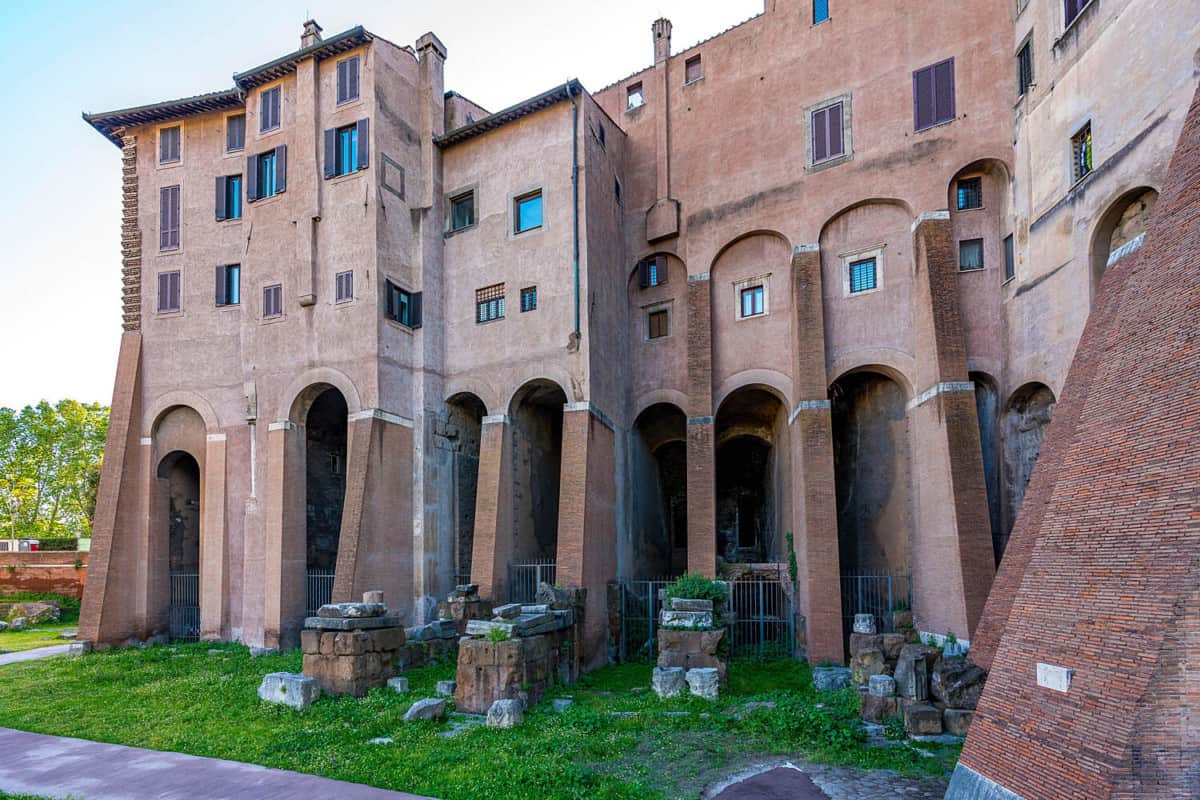
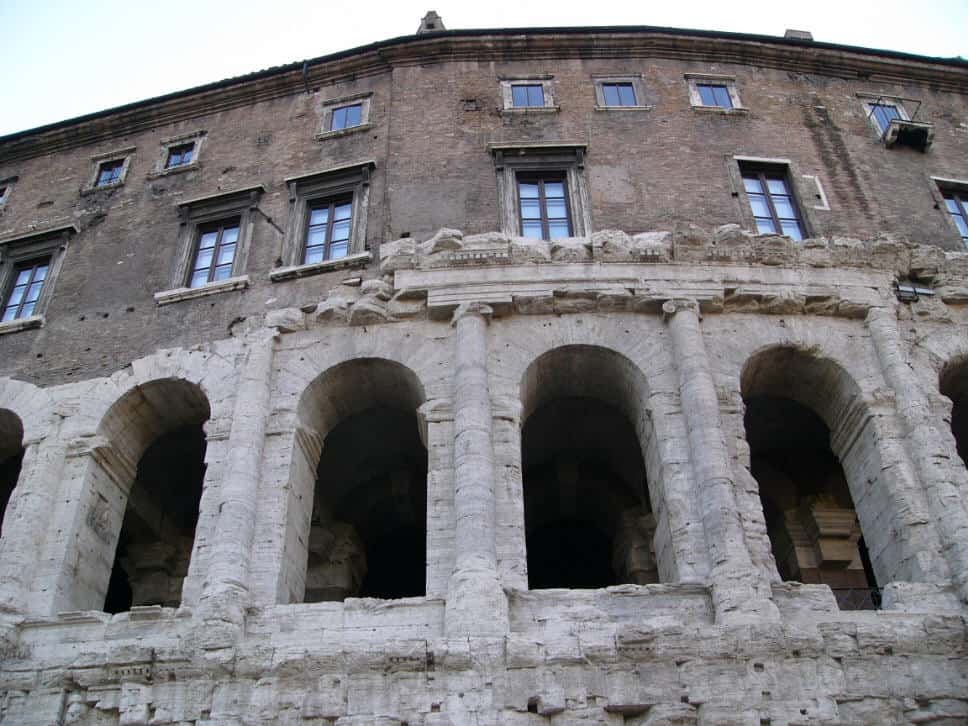
THE CHURCH OF ST. NICHOLAS IN JAIL
Temporarily pass over the Theatre of Marcellus, and approach the Church of St. Nicholas in Jail.
The church seems to be struggling for space among the remains of three temples that once adorned the Forum Holitorium, the spice market, particularly favored by its proximity to the Tiber River and the nearby port. The church occupies the space of the ancient central temple, as well as a small part of the one on the left and one side of the portico on the opposite side. The three temples, one next to the other, had more or less the same layout that can be seen today in the archaeological area of the Argentine Tower, although in this one the temples are further apart both in position and chronology.
On the two sides of the church are still visible the remains of the temples dedicated to Janus and Spes, both datable to the period of the First Punic War (II Century BC) and both partially incorporated in the walls of the church, one with six Doric columns in travertine once covered with stucco to simulate marble, the other with seven Ionic columns.
The central temple, entirely occupied by the church, was the largest of the three and was peripteral, with a triple row of six Ionic style columns on the façade and another eleven along the perimeter: of this temple are preserved part of the steps and three columns, incorporated into the façade of the church. Probably, the temple was built in the II Century BC and was dedicated to the goddess Juno Sospita.
The Church of St. Nicholas in Jail is definitely very old and, although it is formally mentioned only since the 12th Century, linking it to the name of Pope Paschal II, there must have been a diaconia here since the 6th Century AD. The origin of the term “in jail” is rather uncertain: according to scholars, it could derive from the presence of the cells of a medieval prison under the ancient Temple of Juno Sospita, while probably these rooms were only the offices of the moneychangers who worked for the merchants who frequented the Forum Holitorium.
Pope Paschal II built the floor, the marble ambos, the Easter candle, the Schola Cantorum and the episcopal chair: part of this furniture was later taken away by Pope Alexander VI. The present church, as mentioned by an inscription on the left side of the façade, dates back to 1599 and was built by the architect Giacomo Della Porta, on a commission by Cardinal Pietro Aldobrandini, although it underwent several restorations, in 1733 by Pope Clement XII and in 1865 by Pope Pius IX. The church, which was isolated from the houses that flanked it with the works of 1932, presents a slender façade enlivened by an attic, a tympanum and a rose window, and enriched by the heraldic stars of the Aldobrandini family and by bas-reliefs depicting St. Nicholas and the Saints Mark and Marcellinus.
The three naves interior shows evident signs of the recycling of the ancient temples and palaces, also thanks to the splendid reused columns. Next to the entrance is the tomb of the Fabi, who as you know were the ancient owners of the ruins of the Theatre of Marcellus, but the most important work is the altarpiece with the Trinity and the angels, painted in the 17th Century by Guercino.
Visit the evocative underground passages of the church and, as you leave it, observe the massive bell tower, built from a pre-existing tower belonging to the fortifications of the Pierleoni family: inside, the bells cast by Guidotto Pisano in 1286 still ring out.
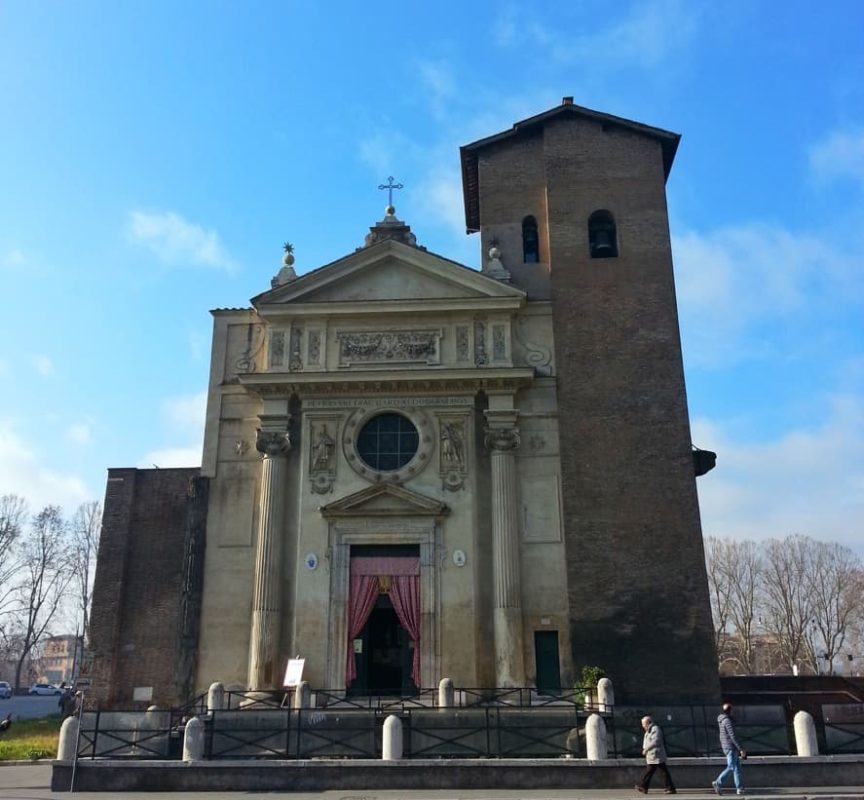
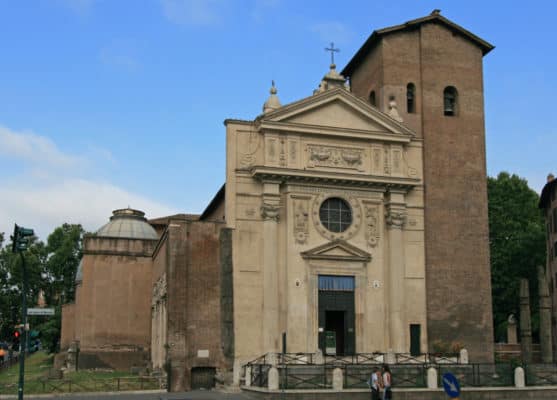
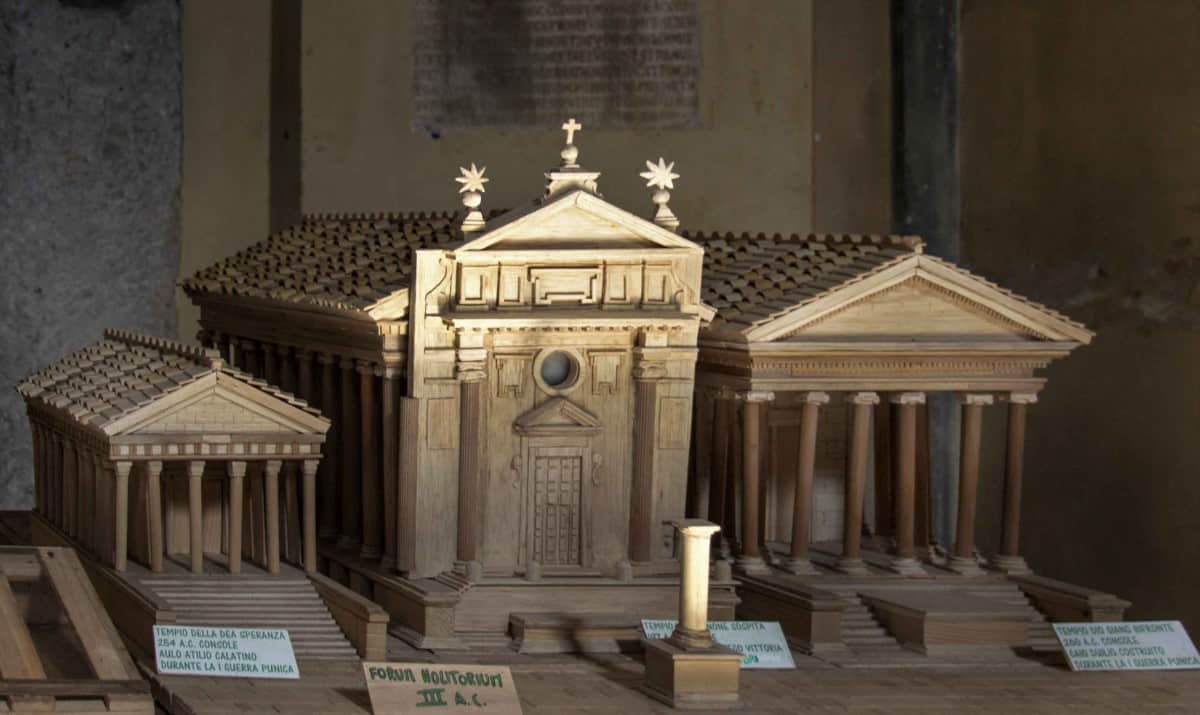
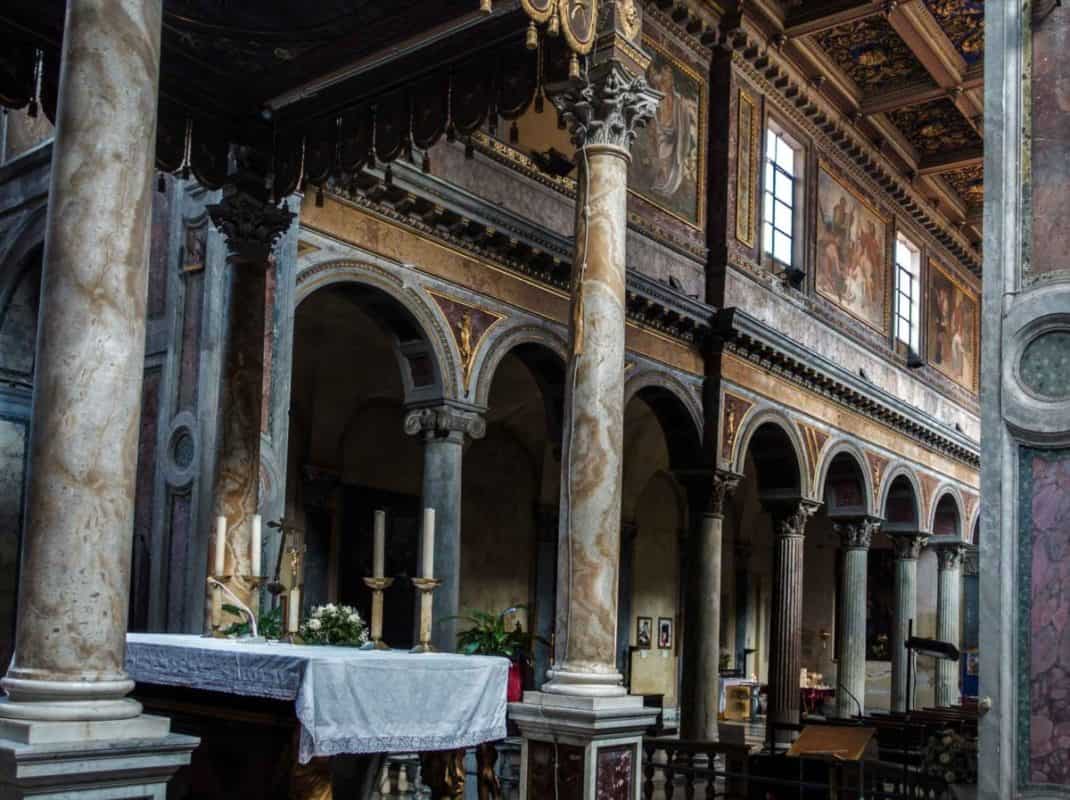
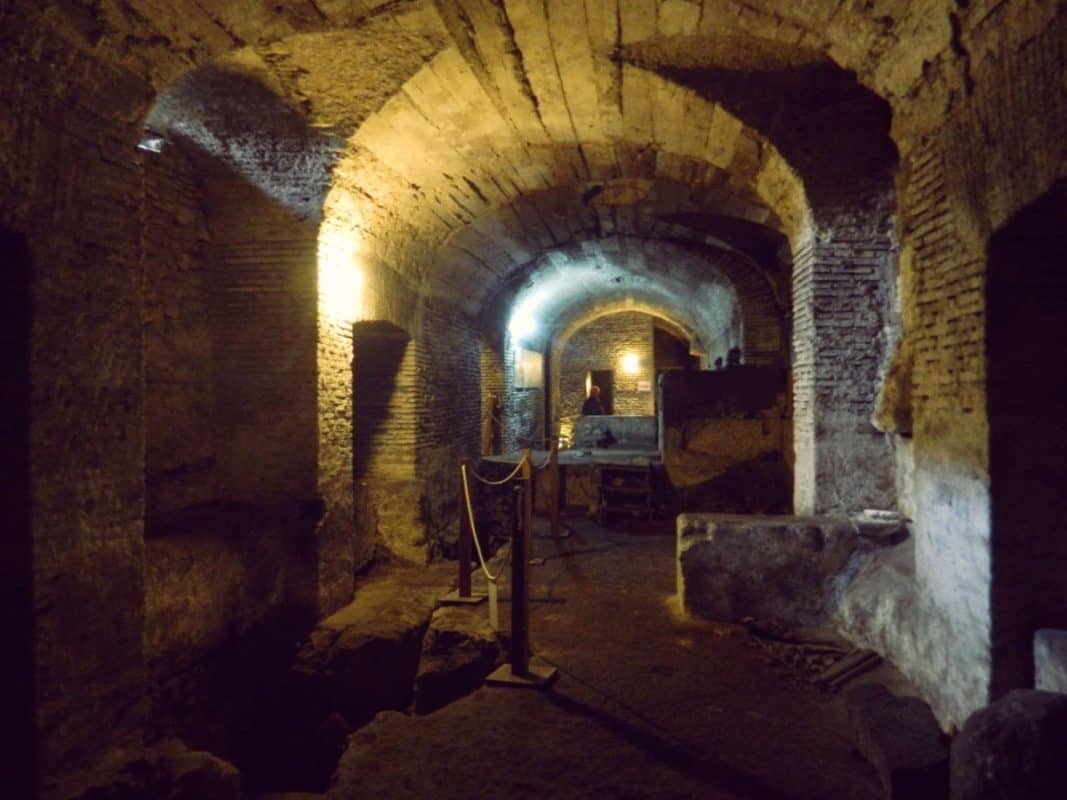
THE THEATER OF MARCELLUS
The Sant’Angelo District is dominated by the massive Theatre of Marcellus, with its huge wrinkles carved by a myriad of vicissitudes. It was Julius Caesar who ordered the construction of this theater, to emulate that of his rival Pompey: the grandeur of the work imposed significant urban adjustments, since the area was already densely populated and full of monuments, and the sacrifice of buildings of great value as the existing Temple of Pietas.
The Theater, completed around 12 BC by Augustus, was dedicated to his nephew Marcellus, son of his sister Octavia, who had died eleven years earlier. 32 meters high, on two floors, with a diameter of almost 130 meters and a capacity of 15,000 spectators, the Theatre of Marcellus had two orders of galleries for a total of 41 arches in travertine. The ground floor was in Doric order, the second floor was in Ionic style and on top of it there was an attic in Corinthian style, in full respect of the tradition dictated by Vitruvius that will also inspire the builders of the Colosseum, finding in it its highest expression.
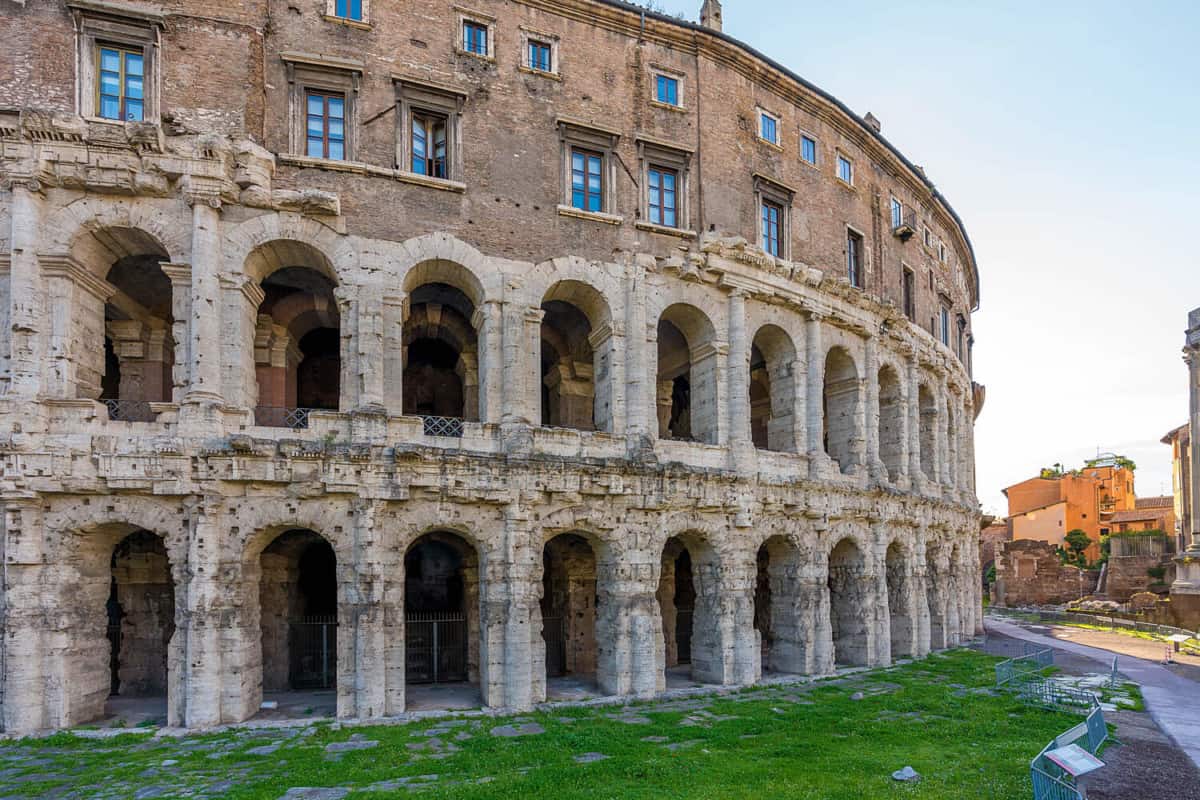
THE TEMPLE OF APOLLO SOSIANUS
Despite the fact that Apollo was very popular in Rome, until the age of Augustus this deity had only one temple within the city: it was located just outside the Carmentalis Gate, between the Forum Holitorium and the Circus Flaminius, and dated back to 431 BC with a dedication to Apollo Medico (Apollo the Physician). Apollo had indeed a number of gifts, ranging from the prediction of the future to archery, from the poetic vein to aesthetics, but in this temple prevailed his thaumaturgical qualities in the treatment of diseases.
Rebuilt after the fearsome siege of the Gauls in 390 BC, it later took the name of Temple of Apollo Sosianus by the consul Caius Sosius, who restored it in 34 BC by inserting within the pediment an extraordinary decoration (now housed in the Museum of the Centrale Montemartini, which you can visit by booking the Museums and Galleries Tour with Rome Guides) with a scene of “Amazonomachia” with Parian marble statues of the V Century BC from a Greek temple of Eretria, including Athena, Hercules, Theseus and many Amazons.
The temple had a portico with six Corinthian columns on the façade and eight semi-columns along the sides. At the time of the Ancient Rome, the temple must have been a real museum, with incredible works of art such as Apollo with the zither by Timarchides.
THE TEMPLE OF BELLONA AND THE COLUMNA BELLICA
The basement on the right of the Temple of Apollo Sosianus belonged in all probability to the Temple of Bellona, built by Appius Claudius Blind in 296 BC, probably to commemorate a victory over the Etruscans. This temple often hosted the Senate, which here decided whether to grant the victorious generals the ovation (a minor award) or the triumph (the highest honor).
In front of it was the so-called Columna Bellica, against which the Romans hurled a spear, symbolically addressing it to their enemy, in a formal declaration of war.
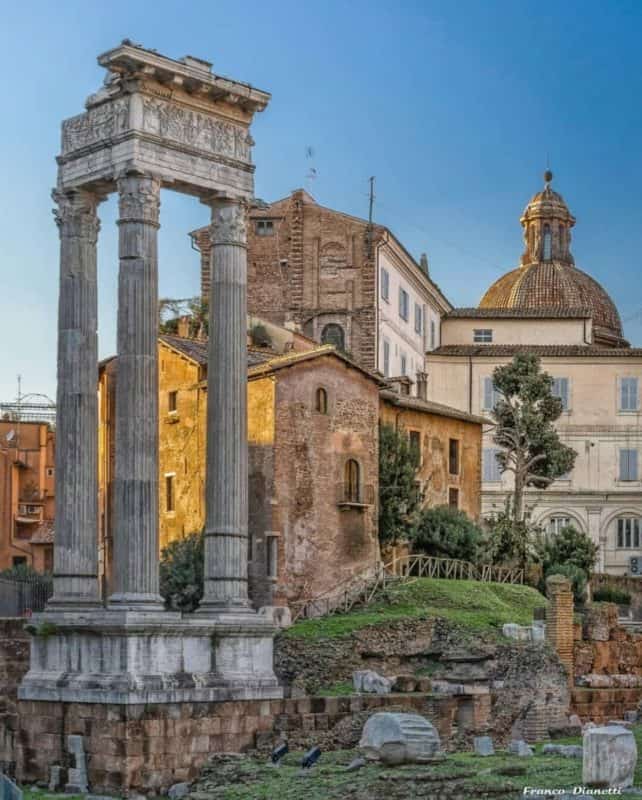
THE VALLATI HOUSE
Go now towards the Porticus of Octavia, if possible walking at the foot of the Theatre of Marcellus and climbing the metal walkway at the end of the street.
You will almost immediately come across the Vallati House, since 1933 used as the headquarters of the Department of Cultural Heritage. The Vallati family, owner between the 13th and the 14th Century of several buildings adjacent to the Theatre of Marcellus and also remembered by a plaque in the Church of St. Angel in the Fish Market (in memory of the illustrious doctor Lorenzo Vallati, who died in 1407), probably owned also this house, which was discovered during the demolition of the city block and subsequently restored between 1929 and 1932, with the extensive use of ancient architectural fragments.
On the side of the Vallati House, a plaque recalls the racist persecution of the last conflict, focusing specifically on the merciless hunt for Jews happened on October 16th 1943, when 2091 Roman citizens were sent to ferocious death in the Nazi extermination camps.
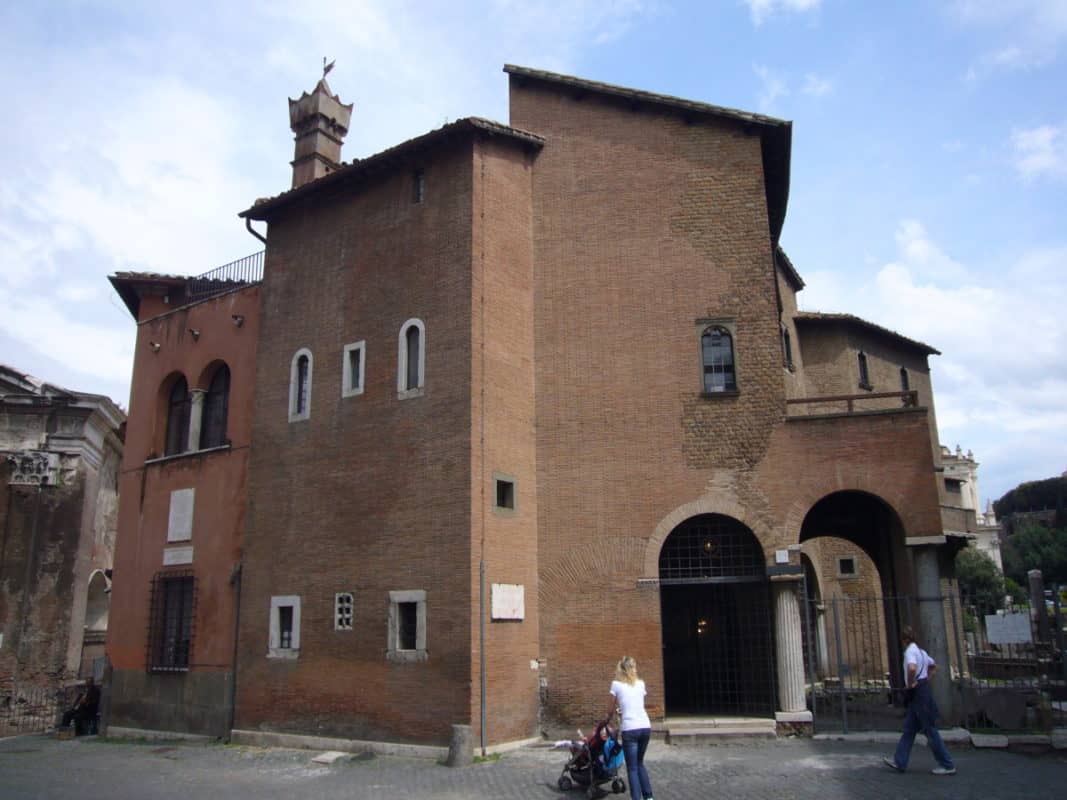
THE PORTICUS OF OCTAVIA
The propylaea of the Porticus of Octavia immediately attract the attention of tourists, thanks to their imposing beauty that shows without hesitation the wounds of the ravages of time. Built in 146 BC by Quintus Caecilius Metellus, nicknamed the Macedonian, and called for this reason Porticus of Metellus, this monumental structure was used to enclose as in a mighty frame the Temples of Juno Queen and Jupiter Stator, erected respectively in 179 and 146 BC.
The loot gained from the Dalmatian War allowed Octavian Augustus to rebuild the whole structure between 35 and 23 B.C., dedicating the new porticus to his sister Octavia. In this way, thanks to the connection with the Theater dedicated to his nephew Marcellus, Augustus created an extraordinary propaganda work, linking the memory of his family to an important reference point for city life. The Porticus was not just decorative, but it served as a shelter for the spectators of the adjoining theater as well as a place for a stroll between shows; inside it were also located two libraries, one for the books in Greek and the other for those in Latin.
The Porticus, which had two entrances, was absolutely gigantic, 119 meters long and 132 meters wide. The inscription you can read on the lintel refers to the restoration carried out by Emperor Septimius Severus and his son Caracalla, at the beginning of the III Century AD.
Before leaving the Porticus of Octavia, you must sharpen your eyes and pay attention to two interesting inscriptions. The first will let you smile, since it forbids playing any kind of game, even legal (so not necessarily gambling), in this square, in its vicinity and in the stores that overlook it, under penalty of a fine.
The other inscription, on the opposite side, is much more important: the one you see posted is only a copy, since the original is on display in the Capitoline Museums. The inscription states that the Roman Conservators were entitled to receive the heads of all fish longer than the size of the marble slab (1.13 meters to be exact): this was a real privilege, which allowed them to make delicious fish soups, and which was abolished in 1798, during the Roman Republic.
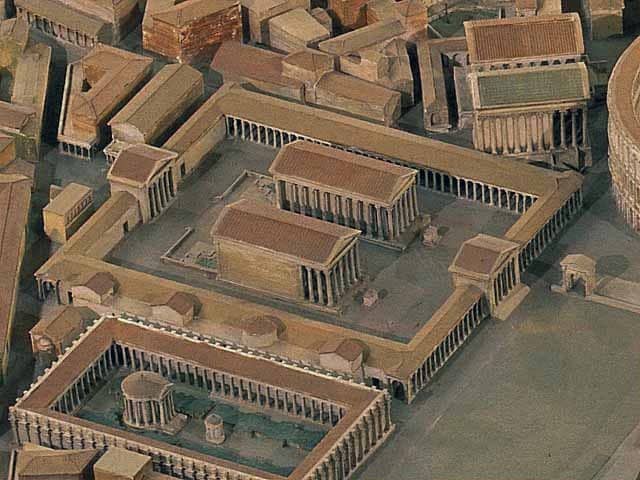
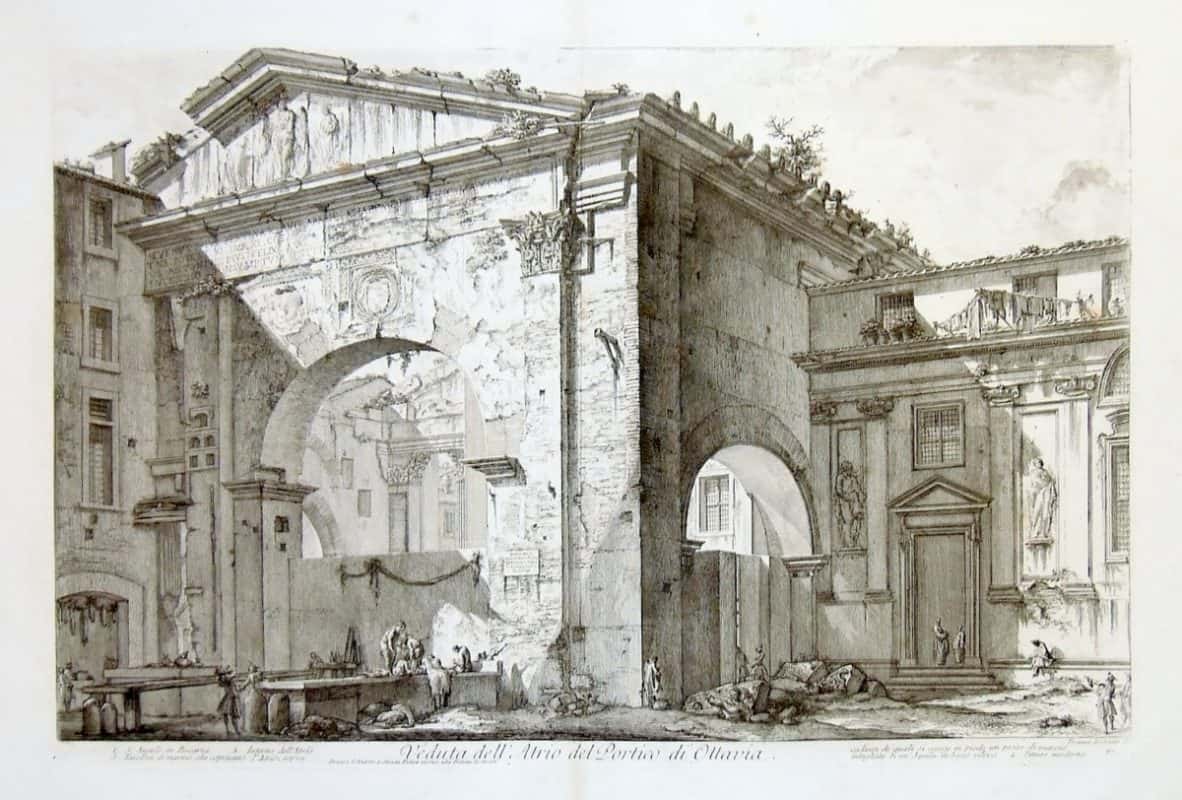
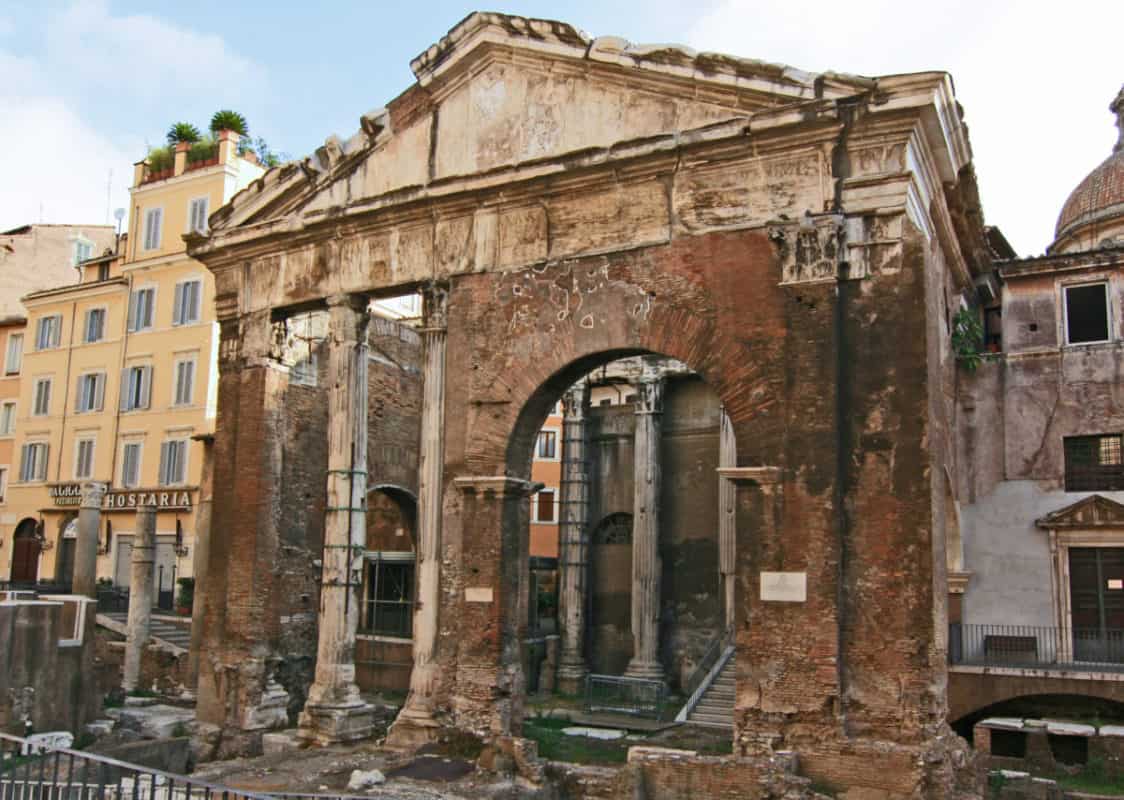
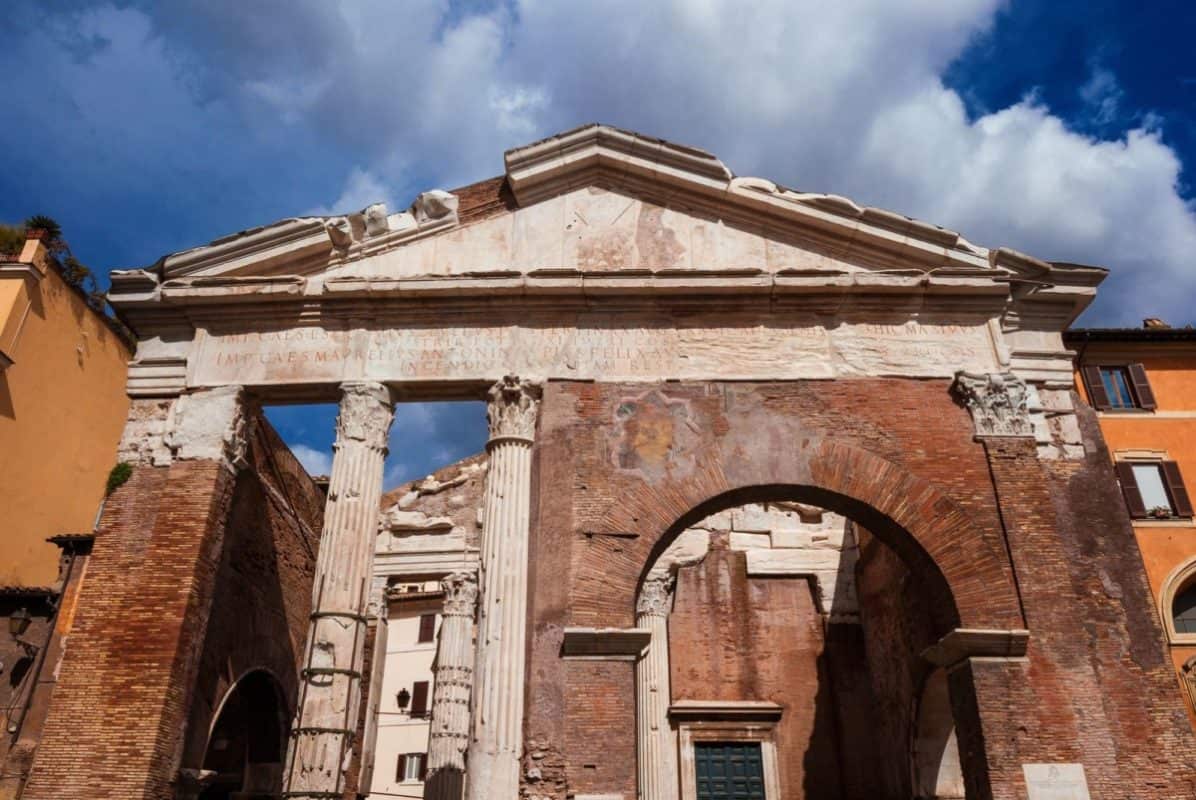
THE CHURCH OF ST. ANGEL IN THE FISH MARKET
The ancient Church of St. Angel in the Fish Market, dating back at least to the 8th Century, was originally dedicated to St. Paul, and changed its titular saint in an unspecified period. The addition “in the Fish Market“, as easily guessed, is linked to the presence of the fish market near the Porticus of Octavia.
Also in this church, together with what happened in the Church of St. Gregory of the Divine Piety and in the Oratory of Carmel, the Dominican Friars performed the already mentioned forced sermons, which the Jews were compelled to attend. The church, which became famous because the famous Tribune Cola di Rienzo listened to 33 consecutive masses there, on May 10th 1347, before going off to attack the Capitol, was restored by Pius IV, Paul V, Benedict XIV and Pius IX between the 17th and 19th Centuries. During the last restoration, unfortunately, the small Romanesque bell tower, dating back to the 13th Century but already seriously compromised, was definitely demolished.
The entrance to this church appears asymmetrical and out of place, in the middle of the ruins of the Porticus of Octavia. In reality, this disjointed entrance derives from the dismantling of the real façade of the church, which stood inside the portico: if you look carefully, you will notice that the porticus retains ample traces of this ancient destination, with coats of arms of cardinals and traces of frescoes on the outside of the brick arch built in medieval times to replace the missing columns.
THE INTERIOR DECORATIONS
The interior has three naves, with the left one slightly irregular. Just at the end of the left aisle there is the little artistic jewel of the church, a fresco detached from the outside of the Rectory, depicting a Madonna and Child and attributed to Benozzo Gozzoli, a painter pupil of Beato Angelico.
On the opposite side, at the end of the right aisle, you can admire the Chapel of St. Andrew, built by the Company of Fishmongers in 1571 and now called the Chapel of the Blessed Sacrament. Its small space contains very precious works of art: the floor in opus sectile (carved marble) depicting the coat of arms of the University of Fishmongers, the frescoes of the vault painted in the 17th Century by Innocenzo Tacconi and the altarpiece by Giorgio Vasari, depicting St. Andrew carrying the cross.
THE ORATORY OF THE FISHMONGERS
Not far away is the Oratory of the Fishmongers, built in 1689 by the University of Fishmongers as a place of prayer and obviously dedicated to St. Andrew, the apostle fisherman. The façade is adorned with a large stucco image of St. Andrew, a 17th Century work by Michel Maille.
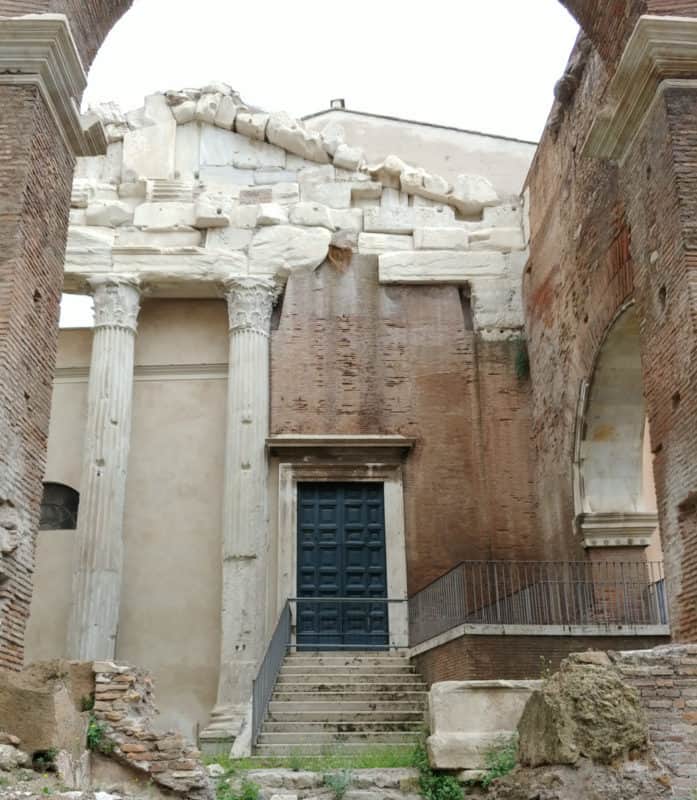
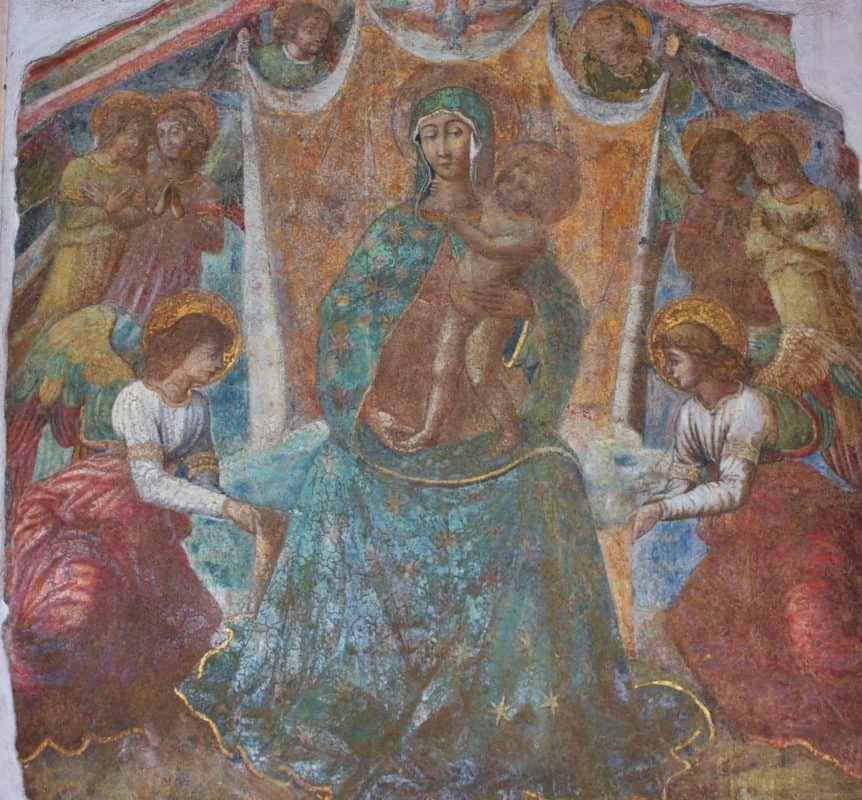
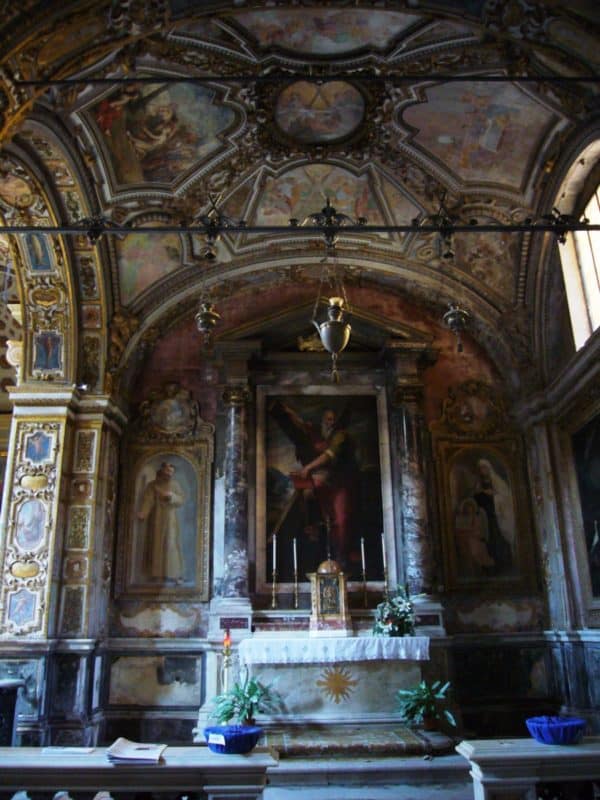
VIA DEL PORTICO DI OTTAVIA
Now take Via del Portico di Ottavia. At number 25, you can see some beautiful architectural fragments reused for the threshold and the frame of the entrance: according to some scholars, this door was the entrance to the lovely tower-house leaning against the Porticus of Octavia, which still has another access from the opposite side and which constitutes a particularly suggestive corner of great architectural interest.
Between numbers 8 and 13 you can see the House of Fabi, ancient owners of the ruins of the Theatre of Marcellus and of several graves inside the Church of St. Nicholas in Jail. The building, despite the renovations, reveals a Renaissance origin.
THE HOUSE OF LORENZO MANILI
After passing the intersection with Via della Reginella, stop at the House of Lorenzo Manili, certainly the most interesting building on the street. The large inscription that runs along the entire façade of the building on two lines eloquently highlights the owner’s passion for antiquity: “While Rome is reborn on its ancient form, Lorenzo Manili for his love of it (Homeland), starts the construction of this house, that from its name is called Manliana, for himself and for his posterity built in proportion to its possibilities in the year 2221 from the foundation of the city, at the age of fifty years, three months and two days, eleven days before the kalends of August (July 20, 1467)“.
Not satisfied with this charming inscription, Lorenzo Manili hoarded classical fragments, incorporating them into the building: a funerary stele from the Appian Way, a relief with a fawn and its cub and a fragment of a sarcophagus depicting a lion devouring an antelope.
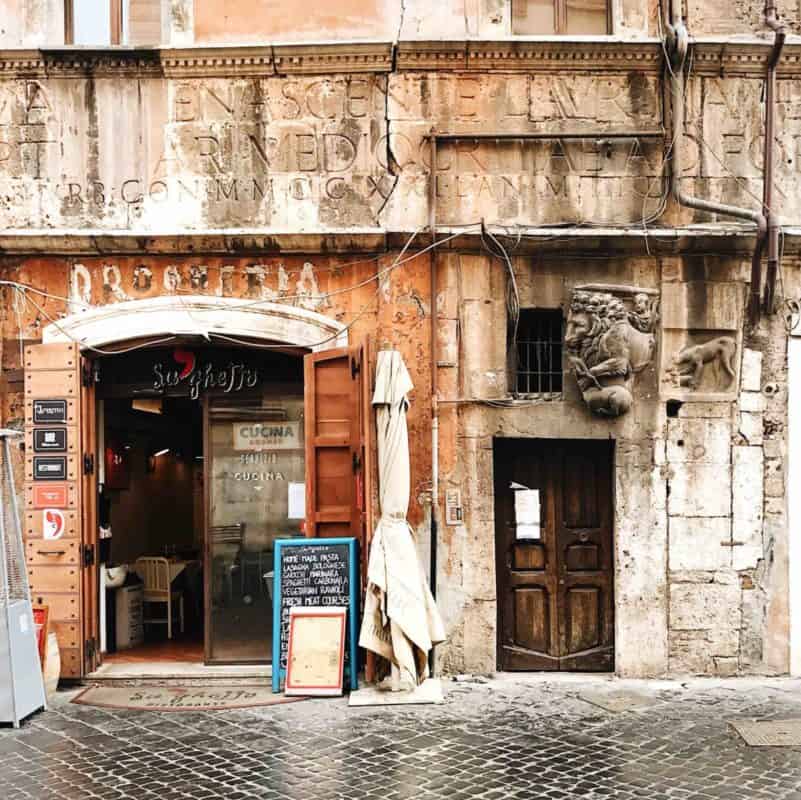
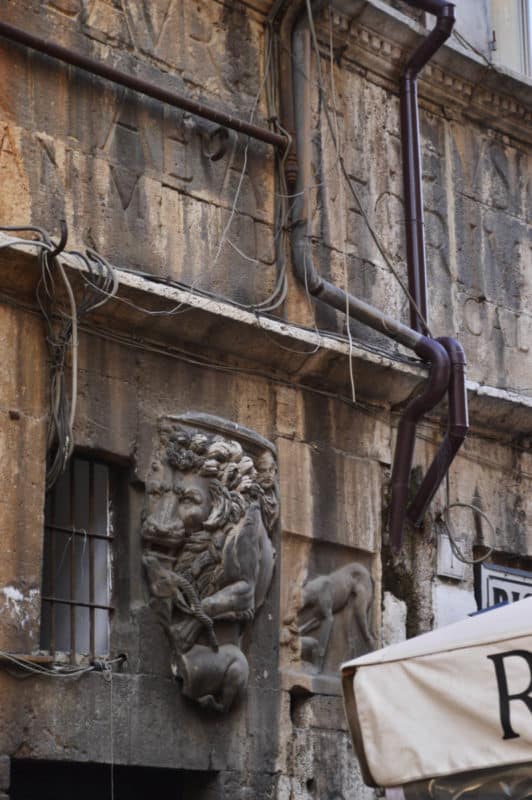
THE GREAT SYNAGOGUE
Now turn your back to the House of Lorenzo Manili, cross the Square of the Five Scole (already discussed in the Itinerary of Rione Regola) and go in front of the Synagogue.
With the institution of the Jewish Ghetto by Pope Paul IV, it was decided to enclose in a single building the five different synagogues of Rome, nicknamed “Five Scole” (the Castilian, the Catalan, the Sicilian, the New and the Italian), each one linked to a different rite. In 1870, following the annexation of Rome to the Italian State, with which the Jews became entitled to the right of citizenship, the Jewish Ghetto was abolished, and in 1888 an agreement was made with the Municipality of Rome for the construction of a single Synagogue that could allow the demolition of the crumbling building of the Five Scole.
The building, designed by the architects Osvaldo Armanni and Vincenzo Costa and inaugurated in 1904, has a distinctive eclectic decoration, which mixes elements of Assyrian-Babylonian, Egyptian and Greek styles.
If you want to visit it, after you have been through a careful security check, be sure to admire the splendid polychrome stained glass windows designed by Cesare Picchiarini and visit the small but very interesting Jewish Museum, which traces in its rooms the secular history of the Jewish community of Rome.
